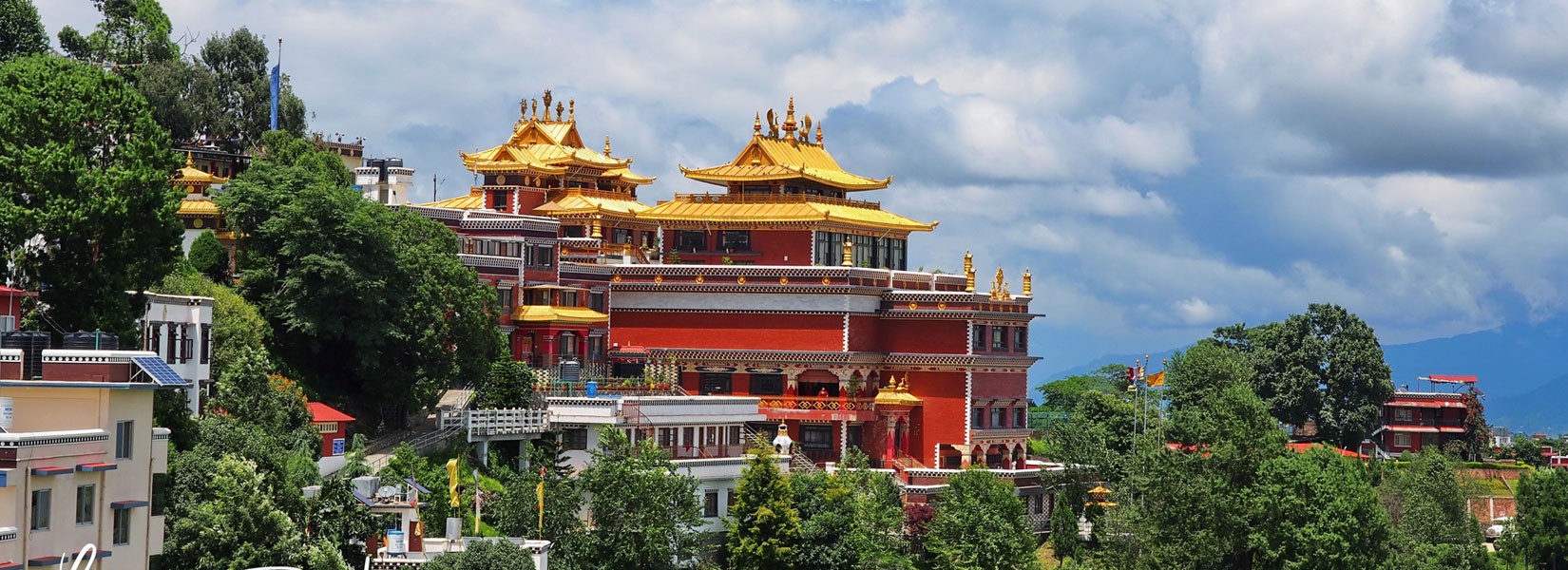The name ‘Namo Buddha’—‘Homage to the Buddha’—originated as a local way of avoiding using the Tibetan name, Takmo Lujin or ‘Body Gift to the Tigress’. There was a superstitious belief that articulating the word ‘tigress’ would be to court bad luck: better by far to evoke the name of the Buddha and his protection from the wild tigers which roamed the region in days gone by.
There are various versions of the legend of Takmo Lujin, all essentially the same and differing only in detail. As related in the Jataka Tales, which chronicle the previous incarnations of Buddha Shakyamuni in both human and animal form, one day Prince Mahasattva (Semchen Chenpo or ‘Great Being’ in Tibetan) and his two brothers were walking through the jungle and encountered a starving tigress with her five newly-born cubs. The brothers continued on their way but Mahasattva, pitying the tigress, returned to her den. Rejecting the idea of hunting the prey for her as this would mean killing one life to save another, he offered the tigress his own body. When his brothers returned to look for him they found only a few bones and locks of hair. The Namo Buddha stupa, grouped with the stupas of Boudhanath and Swayambunath as the three great stupas of the Kathmandu Valley, is believed to enshrine the prince’s remains while one of the grottos on the ridge-top, aglow with butter lamps and draped with khata (votive scarves) is thought to be the very place in which he found the starving tigress sheltering with her cubs.
The area surrounding the stupa, grotto and other holy sites in the vicinity, some with locks of hair and scraps of clothing left by pilgrims, is a mass of prayer flags, which ripple down the hillside beyond in a riot of color: well-worth exploring if time permits and adding your own flags, either purchased in advance in Kathmandu or available along with other religious artifacts in a small on-site store. A traditional grouping of eight stupas, symbolizing key events in the life of Buddha Shakyamuni, is set on a slant on the hillside: looking identical on a first glance, no two are actually the same!
The other area of the Namo Buddha site is that nearest to the small car park and visitors’ restaurant: the extensive and modern Thrangu Tashi Yangste Gompa (monastery).The gompa is named after its founder, Thrangu Rinpoche, a native of Kham (Eastern Tibet) who was recognized as a tulku(reincarnation) able to ultimately trace his incarnations back to the eighth century Guru Rinpoche (Padmasambhava) and later ordained by HH the Sixteenth Karmapa, the head of the Karma Kagyu lineage of Tibetan Buddhism. Like HH the Fourteenth Dalai Lama, Thrangu Rinpoche was forced to flee Tibet in 1959 after the Chinese takeover. Almost twenty years later he started to build the Namo Buddha gompa, developing it step by step from its original basic state, with no road access or running water, to the visually stunning complex it is today, including the main temple, Mahakala Temple, Dewachen Temple, monastic college (shedra), repository of Buddhist texts, school, and guesthouses. HH the Dalai Lama appointed Thrangu Rinpoche as the personal tutor of HH the Seventeenth Karmapa after he too fled Tibet and went into exile in India.
For those happy to wander at will, soak up the spiritual atmosphere, enjoy stunning views of the distant Himalayas on clear days, and explore in detail all that Namo Buddha has to offer, the place offers a relaxing and peaceful day away from the hustle and bustle of Kathmandu.






